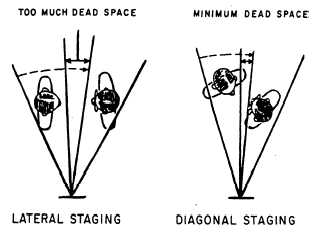Figure 14-43.—Secondary movements.
Secondary Movements
Secondary movements (fig. 14-43) may be used to
follow primary movements or to change or adjust
picture composition. You also may use them to
emphasize or dramatize a certain portion of a
production.
The secondary movements you will become
familiar with are as follows:
l Pan
l Tilt
l Dolly
Zoom
l Truck
. Pedestal
PAN.— A pan is simply the horizontal movement of
the camera on a stationary pedestal used to follow
primary action. When panning, you should try to avoid
“dead space” between subjects. Do this by positioning
the talents diagonally instead of laterally, as shown in
figure 14-44. From the point of view of the camera,
diagonal staging brings the talents closer together.
When the director wants a pan, he will call for pan
left or pan right.
TILT.— Tilting is simply pointing the camera up or
down. The reasons for tilting the camera are similar to
Figure 14-44.—Lateral vs. diagonal staging of talent.
those for panning the camera. For example, the height
of an object can be shown by gradually tilting up on it,
or you could tilt down on something to build suspense.
The director usually indicates to the camera
operator the tilt he wants by ordering tilt up or tilt down.
DOLLY.— Dollying is moving the camera toward
or away from the subject. You can dolly in to increase
gradually the size of an object on the screen, or dolly out
to produce an opposite effect. Likewise, dollying
decreases or increases the field of view.
The director’s orders for dolly are dolly in or dolly
out.
ZOOM.— A zoom is made with a zoom lens. It
looks like a dolly and is used for the same purpose.
During a zoom the camera does not move; therefore,
perspective does not change as it does during a dolly.
The director orders zoom in or zoom out.
TRUCK.— Trucking is the lateral movement of the
camera. It is used to follow lateral subject movement or
to truck the camera parallel to stationary objects. In
either case, camera-to-subject distance does not change.
Truck left or truck right are the director’s orders
to the camera operator.
PEDESTAL.— When the director calls for a
pedestal, the entire camera is either raised or lowered on
the pedestal. Pedestaling can provide the audience with
a high or low perspective of the subject. The pedestal
also can be used to compensate for tall or short camera
operators or talents.
Pedestal up or pedestal down are the director’s
commands.
14-34




